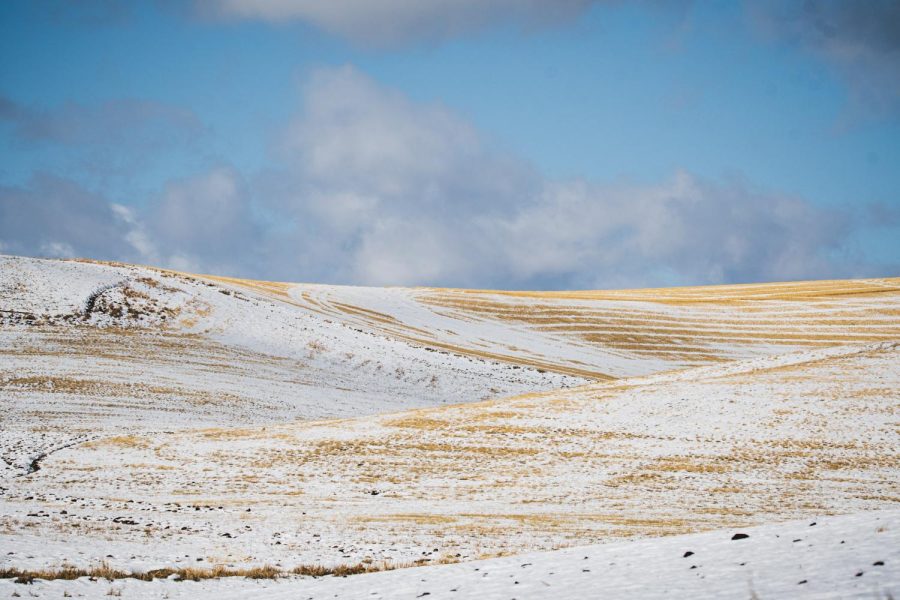Winter wheat production increases this fall
Production rates depend on crop rotation, prices
October 14, 2022
About 1.8 million acres of winter wheat were planted in 2022, an increase of about 100,000 acres from 2021, providing more wheat to those in the region and around the world, said Michelle Hennings, Washington Association of Wheat Growers executive director.
“Ninety percent of Washington wheat we send overseas, so we help feed the world,” she said. “If we have more wheat to sell then that’s a good thing.”
Additionally, Hennings said about 475,000 acres of spring wheat were grown in 2022, a decrease of 100,000 acres compared to 2021, and 72,000 acres of barley were grown, a decrease of 11,000 acres compared to 2021.
Hennings said the WAWG initially believed winter wheat production would be down this year since the previous year was a drought year, leading to fewer crops being grown.
Hennings was not alone in this prediction, as according to the United States Department of Agriculture website, winter wheat was expected to decrease 8% from 2021.
“We did think it was going to be down because usually when you have a drought year it is followed by another drought year,” Hennings said. “When we hit about mid-June we received a lot of moisture that helped the wheat.”
Had the rains not come in June, winter wheat production could have been about half of what it ended up being, which would have been devastating for farmers, Hennings said
Henning said the increase in winter wheat appears to be a regional trend, as Idaho and Oregon have seen similar increases in winter wheat growth.
Northwest winter wheat production is indeed up 59% this year compared to last year, according to Morning AG Clips.
Hennings said some of the factors that can determine an increase or decrease in winter wheat production include changes in the price of wheat and how it is being used as a rotational crop.
“I would say for us the main driver for the main crops we plant is really the crop rotation. Some places can get away with planting wheat year after year after year,” said farmer Dusty Walsh. “We’re pretty locked in in how much winter wheat we can grow based on our rotation.”
Walsh is a co-owner of TD Walsh Farms Inc. Wheat is his main crop, and he went through about 1,800 acres of winter wheat this year.
Walsh said his farm’s winter wheat is probably down from last year because he has been growing winter canola in part of the land where winter wheat is usually grown.
An increase in winter wheat is a positive development for consumers because it gives them access to more food, Hennings said.
“We export our wheat to the Philippines, Japan, areas like that,” she said. “So if we don’t have the supplies then they start to look elsewhere for supplies.”
Walsh said a change in winter wheat production should not affect the consumer too much because so much of the wheat grown here is exported.
“I think Washington grows a significantly more amount of wheat than is actually consumed here. I don’t think this will actually affect the consumer very much,” he said.
At the moment, it is too early to predict if winter wheat will be up or down for next year, Hennings said.
Walsh said both winter wheat and spring wheat are harvested during the summer around July or August, the main difference being winter wheat is planted in the fall and spring wheat is planted in the spring.
Beforehand, Walsh said he had not heard about winter wheat production projected to be down, but he was not surprised about that prediction.
Some of the reasons that the prediction about winter wheat being down are false could be because most surveys are subject to variability and the size of the survey, Walsh said.
“The bigger the sample size the more accurate the survey is,” he said. “I think the final numbers come down to what is actually reported by the USDA.”
In addition, some reasons winter wheat could be up this year is because of the weather conditions, as well as more incentive for farmers to grow winter wheat due to increasing prices, Walsh said.
Another reason that this change should not make much of a difference for the consumer is the cost of wheat does not affect the cost of wheat products for consumers as much as some may think, Walsh said.
Walsh said while it is a bit too early to make a concrete prediction about next year’s winter wheat growth, the weather in the coming months can help make a difference in the winter wheat numbers.
“I would predict our yield for next year might be down a bit because of the hot dry weather,” he said.










